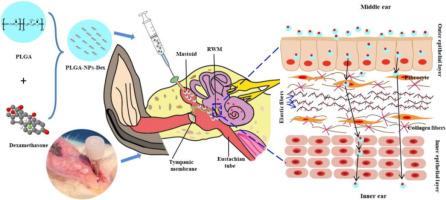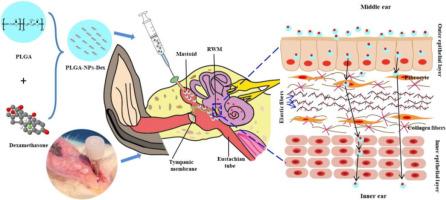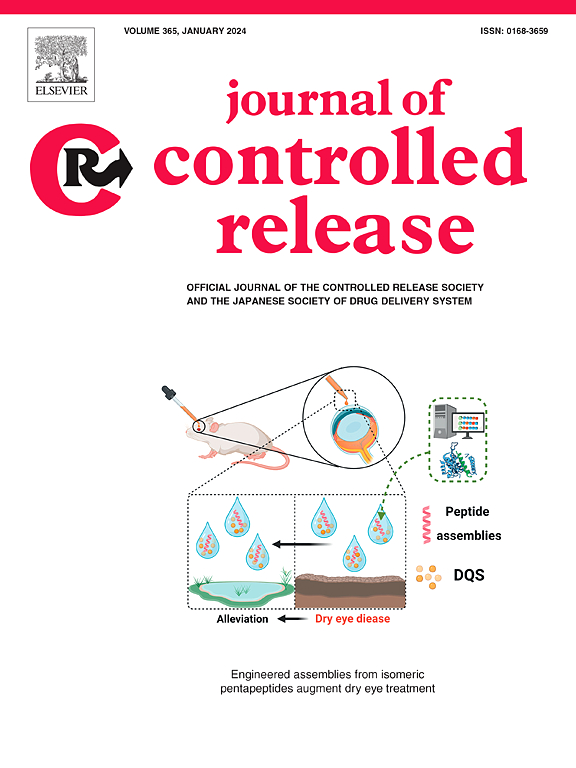向内耳局部给药的乳突方法治疗听力损失
IF 10.5
1区 医学
Q1 CHEMISTRY, MULTIDISCIPLINARY
引用次数: 0
摘要
听力损失是全世界普遍存在的一种残疾。地塞米松(Dex)通常用于治疗听力损失,可全身或局部给药。然而,将地塞米松靶向输送到内耳仍是一项挑战,这限制了它的疗效。本研究旨在开发新的方法,改善 Dex 在内耳的给药,提高其治疗效果。研究人员在豚鼠耳蜗中研究了乳突、腹腔和鼓室内给药途径。采用液相色谱-质谱法和免疫组化法比较了Dex在耳周液中的分布和组织吸收情况。制备了负载Dex的聚(乳酸-共聚乙醇酸)纳米颗粒(PLGA-NPs-Dex),并探讨了它们在圆窗膜(RWM)上的传输机制。在三种给药途径中,乳突给药产生的Dex在淋巴周围的浓度最高。与对照组相比,乳突给药后,PLGA-NPs-Dex 对脂多糖和噪音引起的听力损伤的保护作用明显增强。乳突给药为内耳给药提供了一条便捷的途径,通过这一途径给药的纳米颗粒系统是治疗内耳疾病的一种可行策略。这种方法对内耳造成的损害较小,因此有望在临床上用于治疗听力损失。本文章由计算机程序翻译,如有差异,请以英文原文为准。


Mastoid approach for local drug delivery to the inner ear for treating hearing loss
Hearing loss is a prevalent disability worldwide. Dexamethasone (Dex) is commonly used to treat hearing loss, administered either systemically or locally. However, targeted delivery of Dex to the inner ear remains challenging, which limits its therapeutic efficacy. This study aimed to develop new methods to improve Dex delivery to the inner ear and enhance its treatment effect. Mastoid, intraperitoneal, and intratympanic delivery routes for Dex were investigated in guinea pig cochlea. Liquid chromatography-mass spectrometry and immunohistochemistry were employed to compare the distribution of Dex in the perilymph and tissue uptake. Poly (lactic-co-glycolic acid) nanoparticles loaded with Dex (PLGA-NPs-Dex) were prepared, and their transport mechanism across the round window membrane (RWM) was explored. Among the three delivery routes, mastoid administration produced the highest Dex concentration in the perilymph. Compared to the control, PLGA-NPs-Dex provided significantly enhanced protection against lipopolysaccharide- and noise-induced hearing damage following mastoid administration. Mastoid delivery provides an accessible route for drug delivery to the inner ear and nanoparticle-based systems via this route represent a viable strategy for treating inner ear diseases. This approach caused less damage to the inner ear, making it a promising option for clinical use in treating hearing loss.
求助全文
通过发布文献求助,成功后即可免费获取论文全文。
去求助
来源期刊

Journal of Controlled Release
医学-化学综合
CiteScore
18.50
自引率
5.60%
发文量
700
审稿时长
39 days
期刊介绍:
The Journal of Controlled Release (JCR) proudly serves as the Official Journal of the Controlled Release Society and the Japan Society of Drug Delivery System.
Dedicated to the broad field of delivery science and technology, JCR publishes high-quality research articles covering drug delivery systems and all facets of formulations. This includes the physicochemical and biological properties of drugs, design and characterization of dosage forms, release mechanisms, in vivo testing, and formulation research and development across pharmaceutical, diagnostic, agricultural, environmental, cosmetic, and food industries.
Priority is given to manuscripts that contribute to the fundamental understanding of principles or demonstrate the advantages of novel technologies in terms of safety and efficacy over current clinical standards. JCR strives to be a leading platform for advancements in delivery science and technology.
 求助内容:
求助内容: 应助结果提醒方式:
应助结果提醒方式:


